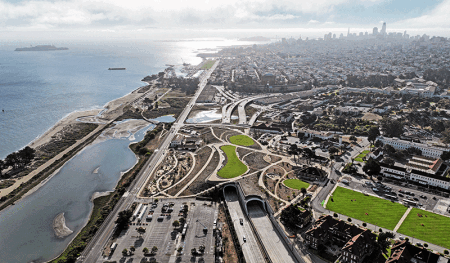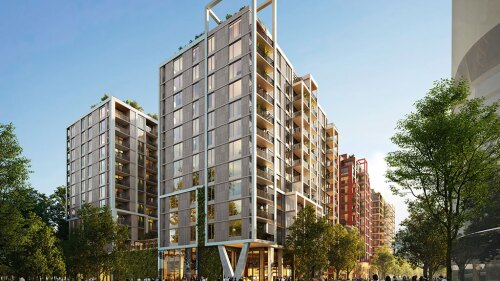Urban highways in the United States have contributed to many of today’s pressing issues, including structural inequities, racial and economic segregation, increased greenhouse gas emissions, elevated exposure to shocks and stresses, and disparities in health outcomes.
Transforming outdated automobile-oriented infrastructure to promote resilience, health, and equity—by identifying community priorities through robust engagement practices, creating new parks and green infrastructure, and employing nature-based solutions while supporting economic activity—can help support quality of life in communities throughout the United States and beyond.
Cities from Pittsburgh to Toronto to San Francisco are retrofitting or removing highways to create connected sidewalks, art installations, and parks. And they are installing features to manage stormwater and mitigate the effects of extreme heat. Community groups, engaged citizens, public-sector agencies, and real estate developers have formed cross-sector coalitions to ensure that new infrastructure supports resilience, economic prosperity, and equitable development.
ULI’s new report, Transportation Transformations: How Highway Conversions Can Pave the Way for More Inclusive and Resilient Places shares promising examples of efforts to reconnect communities divided by highway infrastructure by converting roadways into welcoming, people-centered environments that advance equitable, sustainable, resilient outcomes. Specifically, the report:
- Highlights connections among transportation infrastructure and health, resilience, and real estate development opportunities;
- Makes the case for leveraging public and private funds to support efforts to reconnect communities divided by automobile-oriented infrastructure; and
- Shares promising examples of efforts to reconnect communities through multimodal transportation investments, parks, equitable development, and more.
Highway Routing in the United States
Starting in the mid–20th century, government policies and decisions often routed highways through communities that were, and are, home to significant populations of Black and brown people. Transportation planning decisions are often coupled with land use and zoning policies that promote sprawl and racial and economic segregation. They also fail to address natural hazard risks or to provide equitable access to community amenities, such as parks and other green spaces.
Although momentum for building urban freeways has eased, even today, many state DOTs continue to expand and invest in highway projects that perpetuate harmful results.
The routing of highways in many cities has generated or exacerbated economic inequities and health, climate, and livability disparities for people living nearby. While the national highway system has facilitated interstate automobile travel and commerce, the negative effects of the interstate highway system on communities include the following:
- Residential displacement. Urban highways directly displaced more than 475,000 households—generally in communities of color.
- Exacerbated extreme weather events. The interstate highway system is subject to extreme weather events—such as coastal storms, extreme heat, and flooding—which are increasing in frequency due to climate change. In the United States, there are more than 60,000 miles (97,000 km) of roads and bridges in coastal floodplains that may be at risk for the effects of climate change. Because highways increase the amount of impermeable surface, they contribute to increased flood risk. They also compound the urban heat island effect because roadways absorb and emit heat to a greater extent than most natural surfaces.
- Reduced land values. Highway routing choices reduced local land values for home and business owners.
- Physical barriers. At-grade and elevated highways created barriers within and between communities, disconnecting people from economic opportunities and access to services and community amenities, such as parks.
- Racial and economic segregation. The interstate highway system facilitated the development of many suburban communities, which often excluded people of color, facilitated white flight, and reinforced racial segregation. Communities that are home to historically disenfranchised groups lack equal access to housing and opportunities for economic mobility and may suffer disproportionately when exposed to shocks and stresses, including extreme weather.
- Lower investment in public transportation and regional rail systems. The lower tax base in communities that experienced reduced land values and white flight due to the location of highways led to less profitability for regional transit systems. Less-convenient transit service limits mobility for those who cannot afford a car, who are unable to drive, or who choose not to drive.
- Negative health outcomes. Living near a major highway increases the risk of premature death and numerous health conditions due to air pollution, including asthma, chronic obstructive pulmonary disease, decreased lung function, and a higher risk of dementia.
- Reduced pedestrian safety. Increases in interstate lane miles are directly associated with increases in pedestrian fatalities, for reasons including that pedestrians experience more exposure to automobiles both on and off the interstate.
Contributing to climate change. As of 2021, the transportation sector generated the largest share of greenhouse gas emissions in the United States, contributing 29 percent of emissions. Cars and trucks produce 80 percent of these emissions.
Advancing Highway Conversions
Undoing the harm caused by automobile infrastructure that divides communities is complicated and requires participation by multiple sectors and stakeholders. While projects to turn outdated and underused highways and roadways into parks and community-serving spaces can take many years, there is increasing momentum for action. Examples of the types of investments being made include:
- Stitches are enhanced crossings over highway rights-of-way. Such crossings often include widened sidewalks, bike lanes, seating areas, and open space to support enhanced pedestrian and bicyclist mobility and access to green space. Stitches reduce sound pollution from the right-of-way and make crossings more inviting. Examples include Atlanta’s Fifth Street Pedestrian Plaza Bridge, Columbus’s Long Street Bridge, and Chicago’s BP Pedestrian Bridge.
- Caps are structural covers over highway rights-of-way that support parks and other green spaces, crossing streets, and buildings. Caps can strategically link neighborhoods that a highway separated or divided. Examples include Boston’s Rose Kennedy Greenway that replaced the John F. Fitzgerald Expressway-Central Artery, Dallas’s Klyde Warren Park that covers a section of the Woodall Rodgers Freeway, San Diego’s Teralta Park that covers Interstate 15, the Papago Freeway Tunnel in Phoenix, and the Kansas City Convention Center built over Interstate 670.
- Highway removals involve taking limited-access highways and turning them into lower-capacity surface-level boulevards, green spaces, or waterways. This can dramatically increase safety, reduce traffic, and improve the built environment. Examples include South Harbor Drive in Portland, Oregon; Riverfront Parkway in Chattanooga, Tennessee; and Sheridan Expressway in New York City.
- Public space beneath elevated roadways. Such projects involve creating parks, enhanced public realms, and trails beneath active roadways. Examples include the Bentway in Toronto and the Underline in Miami.
Funding Opportunities
As the United States prepares to make the largest infrastructure investment in a generation, an opportunity exists for key partners to support and leverage equitable and resilient transportation projects that create and sustain community and real estate value.
Through 2026, $590.7 billion will be spent on U.S. transportation networks through the Infrastructure Investment and Jobs Act of 2021, more commonly known as the Bipartisan Infrastructure Law (BIL). Additional federal funding from the Inflation Reduction Act (IRA) of 2022 can fund equitable transportation investments and can potentially be leveraged by the real estate industry.
Specific federal funding programs that can support highway conversion efforts include:
- Reconnecting Communities. The BIL includes the first-ever federal funding program to reconnect communities “cut off from opportunity and burdened by past transportation infrastructure decisions.” The $1 billion Reconnecting Communities discretionary grant program awarded the first $185 million in funding in 2023 to 45 communities, including six capital construction grants and 39 planning grants.
- Neighborhood Access and Equity Grants. The IRA includes more than $3.2 billion for the Neighborhood Access and Equity Grants The program is intended to support projects that improve walkability, safety, and affordable transportation access in communities. It will also address environmental harm caused by transportation projects in disadvantaged communities. The program will reserve $1.1 billion in funding for low-income communities.
- Rebuilding American Infrastructure with Sustainability and Equity (RAISE). The BIL also includes discretionary grant funding to support “safety, environmental sustainability, quality of life, mobility and community connectivity, economic competitiveness and opportunity including tourism, state of good repair, partnership and collaboration, and innovation” through the RAISE.
While there is recent momentum to focus on reconnecting communities by converting harmful highway infrastructure, funding programs under the BIL and the IRA remain relatively small in the context of the total amount of transportation funding across the United States. As of 2020, state and local government funding accounted for roughly 75 percent of highway and road spending, with federal sources making up the other 25 percent.
Overall, up to 87 percent of federal funds that state departments of transportation (DOTs) receive come from formula funds, which can be used for almost all types of transportation projects. According to the American Road & Transportation Builders Association, in fiscal year 2021, 43 percent of federal highway funding went to repair and reconstruction of roadways and 27 percent went to build new roadway capacity. It remains to be seen how states will spend federal highway funding coming from the BIL.
Although up to 50 percent of many federal highway funding programs can be moved into other programs, only 4 percent of eligible federal highway funds is spent on transit projects. Only 2.1 percent of federal transportation funds was designated for walking and biking projects between 2012 and 2016.
These figures show that the status quo still favors spending on roadways—whether for maintenance or for increased capacity—and that projects to reconnect communities are the exception rather than the rule. However, an increased focus on the benefits of different types of transportation projects—including highway conversions—could help shift this balance.
Lessons Learned
Around the country, efforts to repair the social, economic, and environmental harm done by urban highway projects can provide inspiration and guidance for communities aiming to advance similar efforts. Several overarching lessons can be gleaned from highway conversion efforts. A brief overview is below.
- Understand and acknowledge the current and historical context to build trust. Urban highways are often infamous as markers of physical, racial, and economic divides, and they shape the way many people view and experience their cities. Efforts to convert highway infrastructure into spaces that serve communities must first start with understanding the specific historical context and how the consequences of previous transportation decisions affect communities today.
- Create a community-centered process. Community co-creation must play a key role in efforts to repair the harm caused by many urban highway routings. Using a strong, collaborative, and intentional engagement process can help address the need for greater inclusion of marginalized voices in future growth and development.
- Enhance resilience. Highway transformations can enhance resilience through thoughtful design strategies that mitigate acute shocks such as extreme heat and flooding. Transformations can further address chronic stresses by supporting daily quality of life and improved resident health outcomes.
- Leverage public and private funding. Highway transformation projects are complex and typically involve multiple funding sources, including federal, state, and local funds as well as private investments. Leveraging public funds with private investments will be essential in helping level the resource distribution playing field and ensuring highway transformations can produce the greatest possible benefits for communities.
- Embrace nature. Incorporating nature-based solutions in highway conversion projects—including creating, enhancing, and maintaining natural spaces through investments in permeable pavement, trees, greenways, parks, and wetland restoration—can advance ecosystem restoration while protecting against climate change, improving overall community health, increasing access to nature, and supporting real estate success.
- Integrate local storytelling and art. Highway transformation efforts provide opportunities to collect and elevate stories of area residents and share them through the incorporation of art as significant project components. By honoring the perspectives and culture of community residents through art, highway conversions can acknowledge the past, current, and future of those with ties to the local area.









